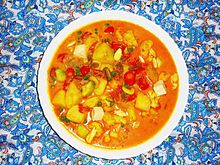Korma
 Chicken korma | |
| Place of origin | Indian subcontinent |
|---|---|
| Associatedcuisine | India,Bangladesh,Pakistan,Afghanistan |
| Main ingredients | meat,yogurt |
Kormaorqorma(Urdu:قورمہ;Hindi:क़ोरमा;Bengali:কোরমা;Persian:قرما) is a dish with its origin in theIndian subcontinent,[1]consisting of meat or vegetablesbraisedwithyogurt,water or stock, and spices to produce a thick sauce orgravy.[2]
Etymology
[edit]The English name is an anglicisation of theHindi-Urduqormā(क़ोरमा, قورمہ), meaning "braise".[3][4]It refers to the cooking technique used in the dish.[2][5]All these words, and the names of dishes such as theIranianghormeh(Persian:قورمه),TurkishKavurmaand theAzerbaijaniqovurmaorkavarma,are ultimately derived from aTurkicwordqawirma,meaning "[a] fried thing".[4]The Indian korma is, however, possibly unrelated in a culinary sense to the modern Turkishkavurmaor to some other dishes using the same root word, as they use widely varying techniques and ingredients.[6]
History
[edit]Korma has its roots in theMughlai cuisine[1]of theIndian subcontinent.A characteristicMughaldish, it can be traced back to the 16th century and to the Mughal expansion into South Asia. Kormas were often prepared in the Mughal court kitchens, such as the famous white korma, perhaps garnished withvark,was said to have been served toShah Jahanand his guests at the inauguration of theTaj Mahal.[7]
Classically, a korma is defined as a dish where meat or vegetables are braised with yogurt or stock. The technique covers many different styles of korma. The flavour of a korma is based on the mixture of spices, including groundcorianderandcumin,combined with yogurt kept belowcurdlingtemperature and incorporated slowly and carefully with the meat juices. Traditionally, this would have been carried out in a pot set over a very low fire, withcharcoalon the lid to provide all-round heat. A korma can be mildly spiced or fiery and may uselamb,goat meat,chicken,beefor game; some kormas combine meat and vegetables, such asspinachandturnip.The termshahi(English:royal), used for some kormas, indicates its status as a prestige dish, rather than an everyday meal, and its association with the court.
Preparation
[edit]

The korma style is similar to otherbraisingtechniques in that the meat or vegetable is first cooked briskly, or seared, using high heat, traditionally withghee,and then subjected to long, slow cooking using moist heat and a minimum of added liquid.[2]The pot may be sealed with dough during the last stages of cooking, using a technique calleddumordampokhtak.[2]
The korma is made using a technique calledbagar.in the later stage of cooking, additional spices are mixed with heatedgheeand then combined with the sauce formed by the braising. The pan is then covered and shaken to release steam and mix the contents.[8]
There is a wide variation between individual korma and other "curry" recipes. Chilli and ginger are often used, but the precise method of preparation results in widely different flavors.Indian bay leavesor driedcoconutmay be added, the latter being a predominantlySouth Indianflavoring.
A kormapilau(pilaf) is a rice and meat dish made with braised meat.[9]
Variations
[edit]In the United Kingdom
[edit]In the United Kingdom, a typical korma as served in curry houses is a mildly spiced dish with a thick sauce. It often featuresalmonds,cashewsor other nuts, andcoconutor coconut milk. In the 21st century, chicken korma has several times been cited as the most popular curry in the UK, replacingchicken tikka masalain surveys of public eating habits.[10][11]
Navratan korma
[edit]
Navratan korma is a vegetarian korma made with vegetables and eitherpaneer(an Indian cheese) or nuts – or sometimes both.[12]Navratanmeans "nine gems", and it is common for the recipe to include nine different vegetables.
Eid korma
[edit]In some parts of South Asia,kormais used to denote a traditionalEid al-Adha(festival of the sacrifice) dish of lamb, goat, or cow that is braised in minimal or no spices. The flavour comes from the meat and fat of the chosen cuts. It was often done to preserve meats for a short-term period, as the fat layer forms a barrier to help prevent spoilage, similar topotted beef.
In Malaysia
[edit]In Malaysia, korma or 'gulai kurma' is traditionally cooked with coconut milk instead of yoghurt among theMalays,as dairy products do not feature heavily in Malay cuisine. Meats used for kurma include chicken, mutton, beef, and deer. It also often contains more vegetables, such as carrots, potatoes, and tomatoes, though this is not a hard-and-fast rule. Some recipes includetamarindas the souring agent, in place of the natural acidity of yoghurt.[13]
See also
[edit]References and notes
[edit]- ^abAnand, Anjum (30 October 2007)."My Chicken Korma".The TimesOnline.Archived fromthe originalon 27 July 2008.
- ^abcdSingh, Dharamjit (1973).Indian Cookery.Penguin. pp. 24–25.ISBN9780140461411.
- ^"Definition of Korma".Merriam-Webster.2022.
Hindi & Urdu qormā, of Turkic origin; akin to Turkish kavurma fried meat, from kavur- to fry, roast
- ^abPerry, C. "Korma, Kavurma, Ghormeh: A family, or not so much?" in Hosking (ed.)Food and Language: Proceedings of the Oxford Symposium on Food and Cooking 2009,p. 254
- ^"korma",Merriam-Webster, accessed 30-01-18
- ^Perry (2009), p. 256
- ^Chapman,India: Food and Cooking,New Holland, 2009, p. 26
- ^Singh, p. 26
- ^Singh, p. 154
- ^"Korma is nation's favourite curry as Brits shun spicy tastes".Daily Telegraph.7 October 2011.Archivedfrom the original on 12 January 2022.Retrieved22 February2020.
- ^"Chicken tikka masala no longer Britain's favourite curry – here's the new titleholder",Daily Mirror,7 October 2017
- ^"Navratan Korma – Nine-gem Curry".about. Archived fromthe originalon 4 March 2016.Retrieved18 June2010.
- ^Resepi Ayam Masak Kurma Che Nom.Retrieved 3 April 2024
External links
[edit] The dictionary definition ofkormaat Wiktionary
The dictionary definition ofkormaat Wiktionary




